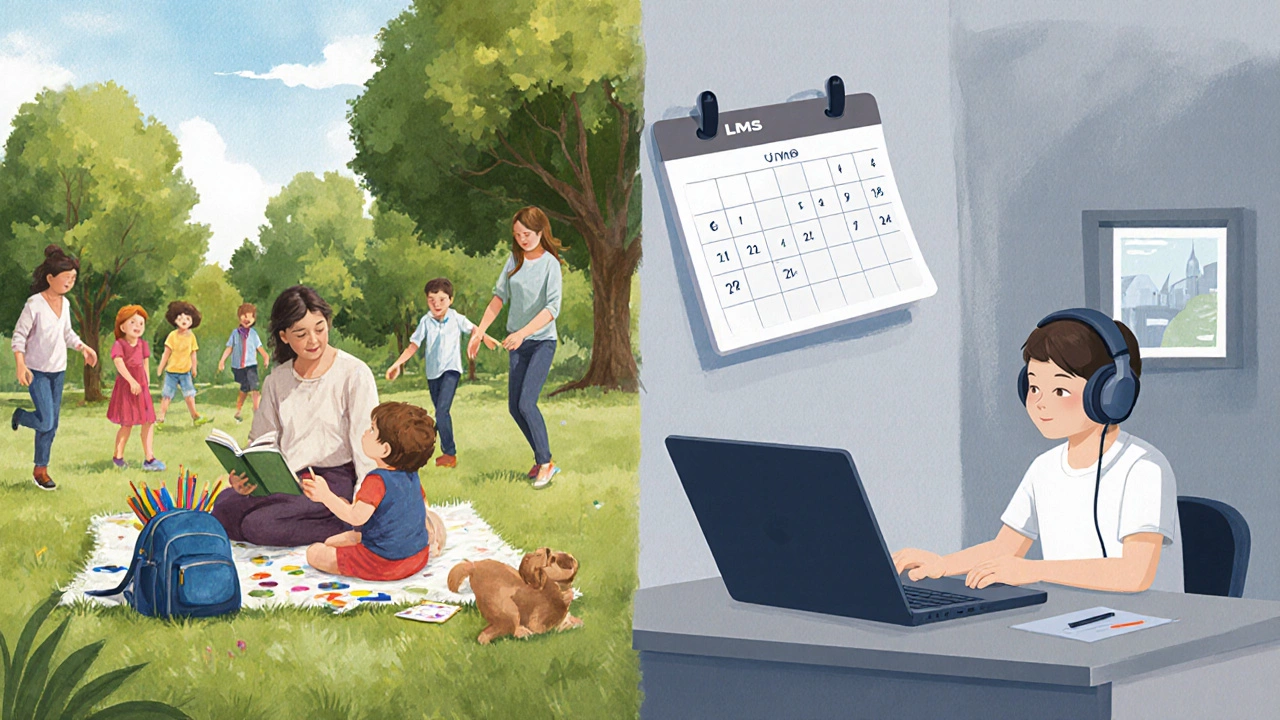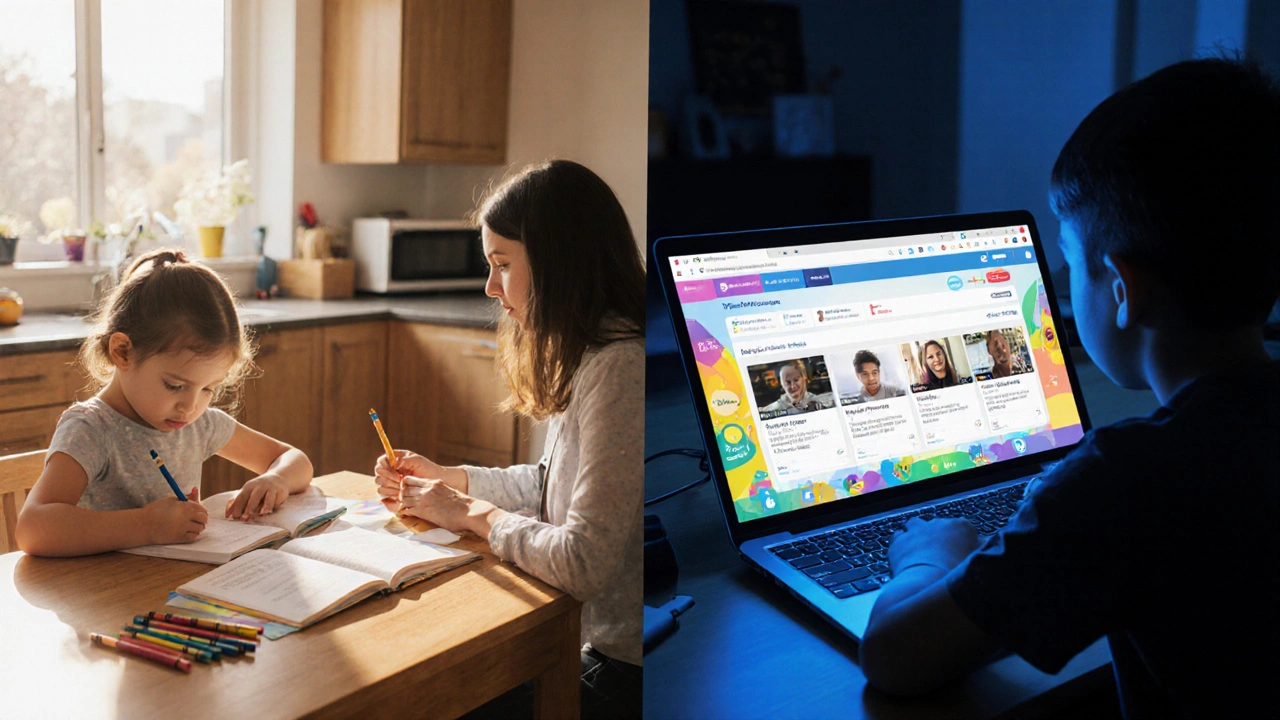Education Model Decision Tool
Which education model is right for your child?
Answer these questions to see which option aligns best with your family's needs.
Ever wonder whether your kid should log in to a virtual classroom or learn at the kitchen table? The choice between Online school is a formal, Internet‑based education system that follows a state‑approved curriculum and often issues recognizable diplomas and Homeschool is a parent‑led approach where families design daily lessons and set the pace at home feels like a high‑stakes gamble, but you can weigh the facts without the stress.
What families actually need to decide
Before you dive into lists of perks, ask yourself three practical questions:
- What learning style does your child thrive in?
- How much flexibility can your schedule handle?
- Which legal and accreditation requirements apply in your state or country?
Answering these questions narrows the field and turns a vague debate into a concrete decision‑tree.
Defining the two models
Learning Management System (LMS) is the software backbone that powers most online schools. It schedules classes, tracks grades, and hosts video lessons, often through a single login portal. Because the LMS handles logistics, teachers can focus on content delivery and live Q&A sessions.
In a homeschool setting, the Parent facilitator is the adult who selects resources, creates a daily timetable, and provides one‑on‑one guidance. That role can range from a part‑time coordinator to a full‑time teacher, depending on the family’s resources.
Key comparison criteria
We’ll look at six factors that show up in almost every parent’s checklist:
- Curriculum control: Who decides what’s taught?
- Social interaction: How does your child meet peers?
- Cost: What’s the price tag, hidden or obvious?
- Flexibility: Can the schedule bend around sports, travel, or health needs?
- Accreditation: Will colleges and employers accept the credentials?
- Special Education Needs (SEN): Is support robust for learning differences?
Each factor carries its own weight, and the “best” model flips depending on what you value most.

Side‑by‑side comparison
| Factor | Online School | Homeschool |
|---|---|---|
| Curriculum control | State‑approved, fixed syllabus delivered through the LMS | Parents pick textbooks, podcasts, or project‑based modules |
| Social interaction | Live classes, virtual clubs, occasional field trips organized by the provider | Community groups, sports leagues, co‑ops, or sibling collaboration |
| Cost | Tuition per student (usually $4,000‑$12,000 per year in the US) | Materials and registration fees; often lower but varies widely |
| Flexibility | Set class times; some schools offer asynchronous modules | Fully adjustable schedule - learn anytime, anywhere |
| Accreditation | Typically accredited by state education departments or recognized agencies | Depends on local regulations; many jurisdictions require yearly assessment |
| SEN support | Built‑in resource rooms, adaptive software, teacher aides | Parent can tailor methods; may need external therapists or tutors |
Pros and cons in everyday life
Online school advantages
- Consistent grading and transcripts that colleges recognize.
- Professional teachers specialize in subjects.
- Structured routine mirrors traditional school days.
Online school drawbacks
- Fixed schedule can clash with extracurriculars.
- Screen fatigue is real after long video lessons.
- Cost can be higher than a DIY homeschool setup.
Homeschool advantages
- Lesson pace matches your child’s rhythm - no rush, no boredom.
- Learning can happen anywhere: park, museum, kitchen.
- Opportunity to weave family values into daily topics.
Homeschool drawbacks
- Parent must invest time in planning or purchase ready‑made curricula.
- Socialization requires extra effort - clubs, sports, co‑ops.
- Accreditation paperwork can be a headache if you’re not familiar with state rules.
Making the decision - a quick checklist
Grab a pen and run through this short list. If a majority of points line up with one model, you’ve got a clear winner.
- Do you need a recognized diploma for college? → Online school.
- Is your child a self‑directed learner who thrives on project work? → Homeschool.
- Do you have the time to design lessons each week? → Online school might be easier.
- Is flexibility for travel, health, or sports crucial? → Homeschool.
- Are you comfortable navigating State accreditation requirements and submitting annual reports? → Online school handles most of that paperwork.
- Do you have access to a strong local homeschool community? → Homeschool.
When you’ve ticked the boxes, the choice becomes less about “better” and more about “right for us.”

Real‑world stories
Case 1 - The tech‑savvy twins: Two 10‑year‑olds in Dublin switched to an online school that uses a robust LMS with gamified quizzes. Their grades jumped 15 % and they still attend a weekend coding club for social time.
Case 2 - The traveling family: A family of four spends three months a year abroad. They homeschool using a blended curriculum, pulling resources from the National Home Education Research Institute and local museums. They file an annual assessment with the Irish Department of Education and their children have no gaps when they return to a traditional school.
Both scenarios work because the families matched the model to their lifestyle.
Common pitfalls and how to avoid them
- Assuming “online” = “hands‑off.” Even the most automated LMS needs a parent or guardian to monitor progress and troubleshoot login issues.
- Overlooking legal requirements. In Ireland, the National Parents Council outlines registration steps for homeschooling; missing a deadline can lead to fines.
- Neglecting social outlets. Schedule regular meet‑ups, sports, or virtual clubs regardless of the model.
- Under‑budgeting. Online schools often charge for extra tutoring, while homeschool families may underestimate the cost of textbooks and field trips.
Bottom line - your next move
There’s no universal answer, but you now have a framework: define your child’s learning style, map out logistics, check accreditation, and weigh cost vs. flexibility. Pick the model that solves the most of your checklist items, and you’ll feel confident that you chose the right path.
Is a homeschool diploma recognized by universities?
Most universities accept a homeschool diploma if it meets the same credit and subject‑area requirements as a traditional high‑school diploma. In Ireland, you’ll need to submit a portfolio and an external assessment to prove equivalence.
Can a child with ADHD thrive in an online school?
Yes, if the online school offers built‑in accommodations such as flexible deadlines, video recordings, and access to on‑demand tutoring. Pairing the LMS with a dedicated therapist can further boost success.
How much does an online school cost on average?
In the United States, tuition ranges from $4,000 to $12,000 per year. European programs often charge lower fees, sometimes as little as €3,000 annually, but taxes and technology fees can add up.
Do I need a teacher’s licence to homeschool?
In Ireland, no formal teaching licence is required for homeschooling, but you must register with the Department of Education and submit an annual learning plan.
What technology do I need for a successful online school experience?
A reliable broadband connection (minimum 25 Mbps), a laptop or desktop, a webcam, and headphones are the basics. Many platforms also recommend a secondary device for note‑taking.






